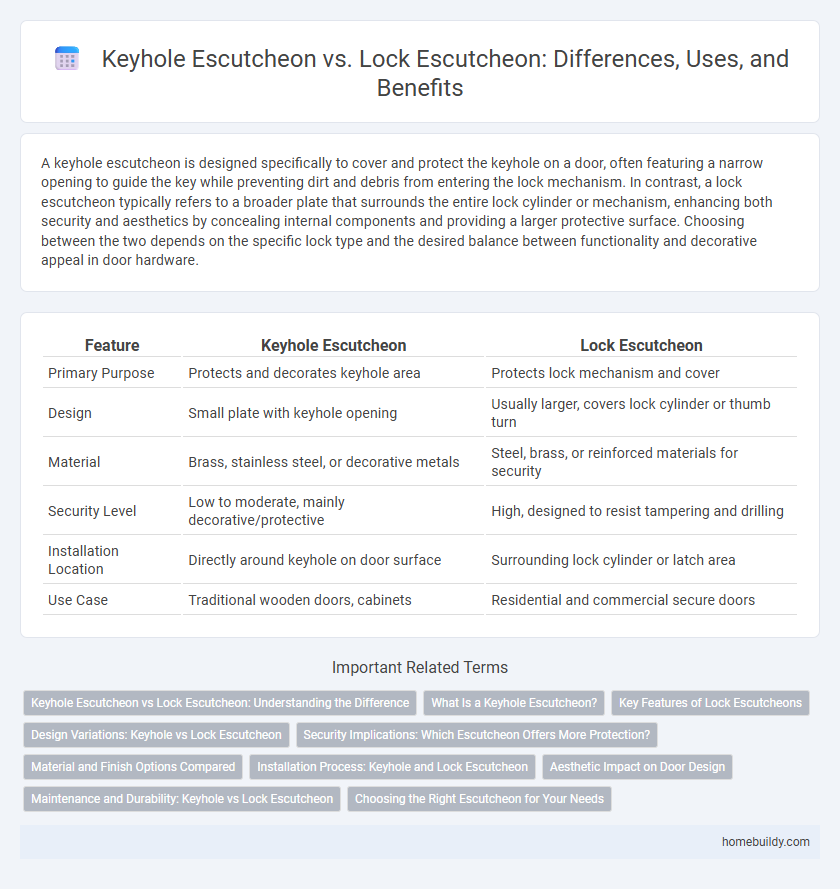A keyhole escutcheon is designed specifically to cover and protect the keyhole on a door, often featuring a narrow opening to guide the key while preventing dirt and debris from entering the lock mechanism. In contrast, a lock escutcheon typically refers to a broader plate that surrounds the entire lock cylinder or mechanism, enhancing both security and aesthetics by concealing internal components and providing a larger protective surface. Choosing between the two depends on the specific lock type and the desired balance between functionality and decorative appeal in door hardware.
Table of Comparison
| Feature | Keyhole Escutcheon | Lock Escutcheon |
|---|---|---|
| Primary Purpose | Protects and decorates keyhole area | Protects lock mechanism and cover |
| Design | Small plate with keyhole opening | Usually larger, covers lock cylinder or thumb turn |
| Material | Brass, stainless steel, or decorative metals | Steel, brass, or reinforced materials for security |
| Security Level | Low to moderate, mainly decorative/protective | High, designed to resist tampering and drilling |
| Installation Location | Directly around keyhole on door surface | Surrounding lock cylinder or latch area |
| Use Case | Traditional wooden doors, cabinets | Residential and commercial secure doors |
Keyhole Escutcheon vs Lock Escutcheon: Understanding the Difference
Keyhole escutcheons are specifically designed to surround the keyhole, providing protection and aesthetic enhancement by covering the keyhole edges and preventing wear. Lock escutcheons, on the other hand, encompass the entire lock mechanism, offering broader security by protecting the lock body from tampering and damage. Understanding the difference between keyhole escutcheons and lock escutcheons helps in selecting the right hardware for door security and design purposes.
What Is a Keyhole Escutcheon?
A keyhole escutcheon is a protective and decorative plate specifically designed to surround a keyhole, enhancing both the aesthetic and functional aspects of a door or furniture piece. It differs from a lock escutcheon, which covers the lock mechanism and often includes a keyhole or thumb turn aperture, providing additional security and style. Keyhole escutcheons focus primarily on protecting the keyhole edges from wear and ensuring smooth key insertion, while lock escutcheons offer broader coverage and integration with locking hardware.
Key Features of Lock Escutcheons
Lock escutcheons provide enhanced security by covering the entire keyhole area, preventing tampering and unauthorized access. These escutcheons are typically designed with robust materials such as stainless steel or brass to withstand forced entry attempts. Unlike keyhole escutcheons that only frame the key slot, lock escutcheons integrate with the locking mechanism, offering additional protection and aesthetic coherence.
Design Variations: Keyhole vs Lock Escutcheon
Keyhole escutcheons feature a minimalist design tailored to expose the keyhole shape for easy access, often crafted in classic or vintage styles to complement traditional locks. Lock escutcheons provide a broader coverage area, integrating additional design elements like snap covers or keyhole protectors, enhancing security and aesthetic appeal. Both types showcase diverse materials such as brass, stainless steel, or antique bronze, with variations in shape and finish to suit specific architectural and security needs.
Security Implications: Which Escutcheon Offers More Protection?
Keyhole escutcheons typically provide less security than lock escutcheons due to their minimal coverage around the keyhole, making the lock cylinder more vulnerable to tampering and drilling. Lock escutcheons feature reinforced plates and shield the lock mechanism more effectively, often incorporating anti-drill and anti-pick elements that enhance resistance against forced entry. Choosing a lock escutcheon increases security by offering superior protection against break-in methods compared to traditional keyhole escutcheons.
Material and Finish Options Compared
Keyhole escutcheons are typically made from brass, stainless steel, or zinc alloy, offering finishes such as satin nickel, antique brass, and polished chrome, designed specifically to highlight and protect the keyhole area. Lock escutcheons often use similar durable materials but provide broader finish options including matte black, oil-rubbed bronze, and brushed steel to match various lock mechanisms and door styles. The choice between keyhole and lock escutcheons depends on both aesthetic preferences and functional requirements, with material thickness and corrosion resistance playing crucial roles in durability.
Installation Process: Keyhole and Lock Escutcheon
Installation of a keyhole escutcheon involves aligning the plate precisely over the keyhole to ensure smooth key entry and exit, often requiring minimal hardware and simple screw fittings. Lock escutcheons demand a more comprehensive installation process, as they must accommodate the entire locking mechanism, including alignment with the latch or deadbolt, often necessitating precise measurements and additional mounting components. Both escutcheon types require careful positioning for optimal security and aesthetic integration, though lock escutcheons typically involve more complex steps due to their functional requirements.
Aesthetic Impact on Door Design
Keyhole escutcheons provide a minimalist aesthetic that blends seamlessly with traditional and rustic door designs, emphasizing subtle elegance without overpowering the door's surface. Lock escutcheons typically feature more substantial, decorative plates that add a bold, ornamental element to the door, enhancing visual interest and often serving as a design focal point. Choosing between a keyhole escutcheon and a lock escutcheon directly influences the door's style, balancing either understated charm or pronounced sophistication in architectural details.
Maintenance and Durability: Keyhole vs Lock Escutcheon
Keyhole escutcheons typically require less maintenance due to their simpler design, which reduces the risk of mechanical failure and corrosion. Lock escutcheons, often incorporating moving parts and additional layers of protection, offer enhanced durability but may need periodic lubrication and adjustment to maintain optimal function. Choosing between the two depends on balancing ease of upkeep with the desired level of security and longevity.
Choosing the Right Escutcheon for Your Needs
Keyhole escutcheons provide a precise fit around keyholes, offering protection against wear and enhancing door aesthetics while maintaining easy key access. Lock escutcheons, designed for modern lock cylinders, offer greater security features such as anti-drill and anti-pick properties tailored for high-security doors. Selecting the right escutcheon depends on the type of lock mechanism, security requirements, and design preferences, ensuring optimal protection and functionality.
Keyhole escutcheon vs Lock escutcheon Infographic

 homebuildy.com
homebuildy.com